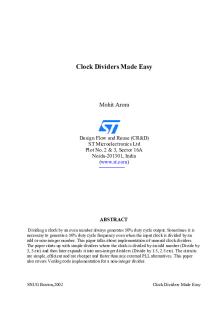Parallel Current Dividers PDF

| Title | Parallel Current Dividers |
|---|---|
| Author | اياد سعيد احمد سفر |
| Course | Internal medicine |
| Institution | جامعة بغداد |
| Pages | 3 |
| File Size | 173.3 KB |
| File Type | |
| Total Downloads | 44 |
| Total Views | 143 |
Summary
aassddrree123...
Description
Parallel Current Dividers Current Divider circuits have two or more parallel branches for currents to flow through but the voltage is the same for all components in the parallel circuit
Current Divider Circuits are parallel circuits in which the source or supply current divides into a number of parallel paths. In a parallel connected circuit, all the components have their terminals connected together sharing the same two end nodes. This results in different paths and branches for the current to flow or pass along. However, the currents can have different values through each component. The main characteristic of parallel circuits is that while they may produce different currents flowing through different branches, the voltage is common to all the connected paths. That is VR1 = VR2 = VR3 … etc. Therefore the need to find the individual resistor voltages is eliminated allowing branch currents to be easily found with Kirchhoff’s Current Law, (KCL) and of course Ohm’s Law.
Resistive Voltage Divider The easiest to understand, and most basic form of a passive current divider network is that of two resistors connected together in parallel. The Current Divider Rule allows us to calculate the current flowing through each parallel resistive branch as a percentage of the total current. Consider the circuit below.
Resistive Current Divider Circuit
Here this basic current divider circuit consists of two resistors: R1, and R2 in parallel which splits the supply or source current IS between them into two separate currents IR1 and IR2 before joining together again and returning back to the source.
As the source or total current equals the sum of the individual branch currents, then the total current, IT flowing in the circuit is given by Kirchoffs current law KCL as being:
IT = IR1 + IR2 As the two resistors are connected in parallel, for Kirchhoff’s Current Law, (KCL) to hold true it must therefore follow that the current flowing through resistor R1 will be equal to:
IR1 = IT – IR2 and the current flowing through resistor R2 will be equal to:
IR2 = IT – IR1 As the same voltage, (V) is present across each resistive element, we can find the current flowing through each resistor in terms of this common voltage as it is simply V = I*R following Ohm’s Law. So solving for the voltage (V) across the parallel combination gives us:
Solving for IR1 gives:
Likewise, solving for IR2 gives:
Notice that the above equations for each branch current has the opposite resistor in its numerator. That is to solve for I1 we use R2, and to solve for I2 we use R1. This is because each branch current is inversely proportional to its resistance resulting in the smaller resistance having the larger current....
Similar Free PDFs

Parallel Current Dividers
- 3 Pages

Clock Dividers Made Easy
- 19 Pages

Parallel Circuits
- 50 Pages

Series and Parallel rev617
- 8 Pages

Biology 1 2020 notebook dividers 2
- 12 Pages

Current meter
- 6 Pages

Series-Parallel Circuits
- 2 Pages
![Parallel Processing[1]](https://pdfedu.com/img/crop/172x258/z4xp2vpo4y7l.jpg)
Parallel Processing[1]
- 16 Pages

Parallel Computing notes
- 17 Pages

Parallel axis theorem report
- 5 Pages

Parallel Seriel Bus
- 2 Pages

Parallel Axis Theorem
- 2 Pages
Popular Institutions
- Tinajero National High School - Annex
- Politeknik Caltex Riau
- Yokohama City University
- SGT University
- University of Al-Qadisiyah
- Divine Word College of Vigan
- Techniek College Rotterdam
- Universidade de Santiago
- Universiti Teknologi MARA Cawangan Johor Kampus Pasir Gudang
- Poltekkes Kemenkes Yogyakarta
- Baguio City National High School
- Colegio san marcos
- preparatoria uno
- Centro de Bachillerato Tecnológico Industrial y de Servicios No. 107
- Dalian Maritime University
- Quang Trung Secondary School
- Colegio Tecnológico en Informática
- Corporación Regional de Educación Superior
- Grupo CEDVA
- Dar Al Uloom University
- Centro de Estudios Preuniversitarios de la Universidad Nacional de Ingeniería
- 上智大学
- Aakash International School, Nuna Majara
- San Felipe Neri Catholic School
- Kang Chiao International School - New Taipei City
- Misamis Occidental National High School
- Institución Educativa Escuela Normal Juan Ladrilleros
- Kolehiyo ng Pantukan
- Batanes State College
- Instituto Continental
- Sekolah Menengah Kejuruan Kesehatan Kaltara (Tarakan)
- Colegio de La Inmaculada Concepcion - Cebu



